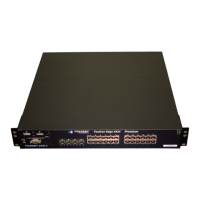Foundry Configuration Guide for the FESX, FSX, and FWSX
11 - 10 © Foundry Networks, Inc. December 2005
Figure 11.6 Use virtual routing interfaces for routing between Layer 3 protocol VLANs
VLAN and Virtual Routing Interface Groups
To simplify configuration, you can configure VLAN groups and virtual routing interface groups. When you create a
VLAN group, the VLAN parameters you configure for the group apply to all the VLANs within the group.
Additionally, you can easily associate the same IP sub-net interface with all the VLANs in a group by configuring a
virtual routing interface group with the same ID as the VLAN group.
For configuration information, see “Configuring VLAN Groups and Virtual Routing Interface Groups” on page 11-
40.
Dynamic, Static, and Excluded Port Membership
When you add ports to a protocol VLAN, IP sub-net VLAN, IPX network VLAN, or AppleTalk cable VLAN, you can
add them dynamically or statically:
• Dynamic ports
• Static ports
You also can explicitly exclude ports.
VE 1
Layer 2 and Layer 3 traffic within a VLAN
is bridged at Layer 2.
Layer 3 traffic between protocol VLANs
is routed using virtual interfaces (VE).
To route to one another, each protocol
VLAN must have a virtual interface.
User-configured port-based VLAN
User-configured protocol VLAN, IP sub-net VLAN,
IPX network VLAN, or AppleTalk cable VLAN
VE 3
VE 4
VE 2
VE = virtual interface
(”VE” stands for “Virtual Ethernet”)

